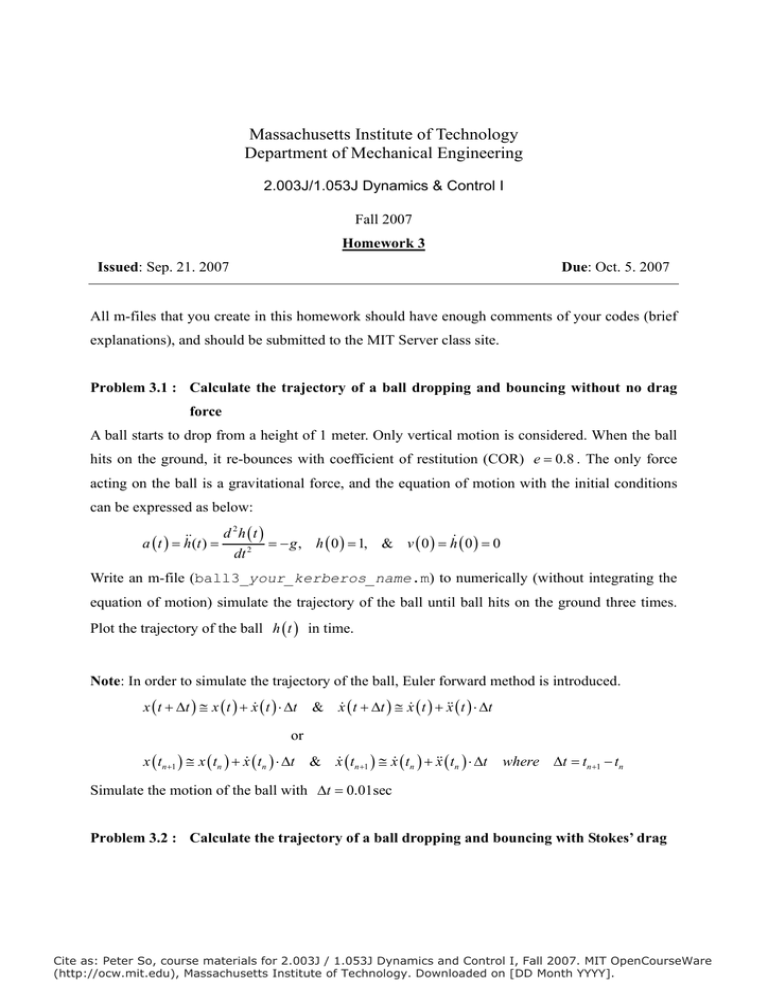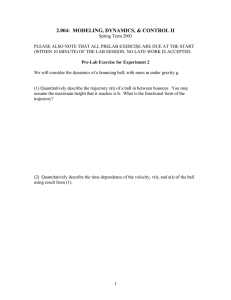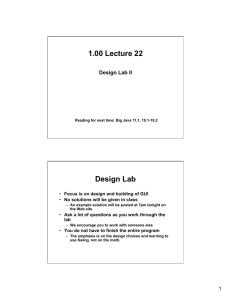Document 13664921
advertisement

Massachusetts Institute of Technology Department of Mechanical Engineering 2.003J/1.053J Dynamics & Control I Fall 2007 Homework 3 Issued: Sep. 21. 2007 Due: Oct. 5. 2007 All m-files that you create in this homework should have enough comments of your codes (brief explanations), and should be submitted to the MIT Server class site. Problem 3.1 : Calculate the trajectory of a ball dropping and bouncing without no drag force A ball starts to drop from a height of 1 meter. Only vertical motion is considered. When the ball hits on the ground, it re-bounces with coefficient of restitution (COR) e = 0.8 . The only force acting on the ball is a gravitational force, and the equation of motion with the initial conditions can be expressed as below: d 2h (t ) & & a ( t ) = h (t ) = = −g, h ( 0 ) = 1, & v ( 0 ) = h& ( 0 ) = 0 dt 2 Write an m-file (ball3_your_kerberos_name.m) to numerically (without integrating the equation of motion) simulate the trajectory of the ball until ball hits on the ground three times. Plot the trajectory of the ball h ( t ) in time. Note: In order to simulate the trajectory of the ball, Euler forward method is introduced. x ( t + Δt ) ≅ x ( t ) + x& ( t ) ⋅ Δt & x& ( t + Δt ) ≅ x& ( t ) + && x ( t ) ⋅ Δt or x ( tn+1 ) ≅ x ( tn ) + x& ( tn ) ⋅ Δt & x& ( tn+1 ) ≅ x& ( tn ) + && x ( tn ) ⋅ Δt where Δt = tn+1 − tn Simulate the motion of the ball with Δt = 0.01sec Problem 3.2 : Calculate the trajectory of a ball dropping and bouncing with Stokes’ drag Cite as: Peter So, course materials for 2.003J / 1.053J Dynamics and Control I, Fall 2007. MIT OpenCourseWare (http://ocw.mit.edu), Massachusetts Institute of Technology. Downloaded on [DD Month YYYY]. We assume that the velocity of the ball dropping and bouncing is low enough, and introduce Stokes’ drag which resists movement of the ball, and linearly proportional to speed. The equation of motion can be expressed as below: a ( t ) = h&&(t ) = d 2h (t ) dt 2 = − g − bh& ( t ) = − g − bv ( t ) , h ( 0 ) = 1, & v ( 0 ) = h& ( 0 ) = 0 write an m-file (ball3stokes_your_kerberos_name.m) with b = 0.8 to numerically (without integrating the equation of motion) simulate the trajectory of the ball until ball hits on the ground three times. Plot the trajectory of the ball h ( t ) in time. Problem 3.3 : Calculate the trajectory of a ball dropping and bouncing with quadratic drag Consider the case where the drag is quadratic to velocity instead. The equation of motion can be expressed as below: a ( t ) = h&&(t ) = d 2h (t ) = − g − ch& ( t ) h& ( t ) = − g − cv ( t ) v ( t ) dt 2 h ( 0 ) = 1, & v ( 0 ) = h& ( 0 ) = 0 Write an m-file (ball3quadratic_your_kerberos_name.m) with c = 0.5 to numerically (without integrating the equation of motion) simulate the trajectory of the ball until ball hits on the ground three times. Plot the trajectory of the ball h ( t ) in time. Problem 3.4 : Calculate a more accurate trajectory of the ball with a given spatial resolution (Bonus, very difficult) Go back to Problem 3.1. The result shows ball bounces when it is not exactly at the ground (either above or below) due to the finite precision of our numerical simulation. We will look to how to get a better simulation for the motion of the ball. We can take smaller time step size Δt and that will definitely produce accurate trajectory (try). However, it requires much more computation to do simulation with smaller Δt . Therefore, we introduce adaptive time step size especially in the region close to the ground. Write an m-file (ball3spatial_your_kerberos_name.m) to simulate the motion of the ball that satisfies h ( tb ) < 0.01 where tb : is the time when the ball bounces. (Hint: What we meant by Cite as: Peter So, course materials for 2.003J / 1.053J Dynamics and Control I, Fall 2007. MIT OpenCourseWare (http://ocw.mit.edu), Massachusetts Institute of Technology. Downloaded on [DD Month YYYY]. adapative time step size is the following. Modify the algorithm when the ball bounces. If you find that the ball goes below ground and h ( tb ) < 0.01 is not satisfied, take the ball back one time step and then reinitiate Euler procedure with a smaller time interval (say 1 Δt ). Then try 2 again in that region. Repeat this procedure until you can satisfy the criterion. Discuss it with TA) Cite as: Peter So, course materials for 2.003J / 1.053J Dynamics and Control I, Fall 2007. MIT OpenCourseWare (http://ocw.mit.edu), Massachusetts Institute of Technology. Downloaded on [DD Month YYYY].




